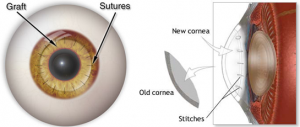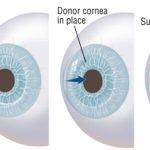A cornea transplant (keratoplasty) is a surgical procedure to replace part of your cornea with corneal tissue from a donor. Your cornea is the transparent, dome-shaped surface of your eye that accounts for a large part of your eye’s focusing power.
Cornea Transplantation

Cornea transplantation (keratoplasty) is a surgical procedure to replace part of the cornea with a donor corneal tissue. The cornea is a clear layer on the front of the eye that helps the light focus so that you can see clearly. A cornea transplant can improve vision, minimize discomfort and improve the appearance of a cornea that is damaged or diseased.
When Cornea Transplantation is required:
A cornea transplant is most commonly used to restore vision to a person with a cornea that has been damaged. A cornea transplant may often reduce pain or other signs and symptoms related to corneal disease.
A number of issues may be treated by a transplant of the cornea including:
- Cornea scarring due to injuries or infection
- Corneal ulcers or sores due to infection
- A medical condition that causes the cornea to bulge.
- Corneal thinning, blurring, or swelling
- Inherited eye diseases include dystrophy in Fuchs and others
- Problems with earlier eye operation
Cornea Transplantation Procedure
A sedative may be given to the patient to help them relax and a local anesthetic to numb the eye. In the most common type of corneal transplantation, the surgeon cuts through the entire thickness of the abnormal or diseased cornea to remove a small button-sized corneal tissue disk. To make the precise circular cut, a tool that acts like a trephine is used. The donor cornea is placed within the opening, cut to fit. The surgeon then threads the new cornea into place using a fine thread.
Transplantation procedure of a part of the cornea
A full thickness cornea transplant is not necessarily the most effective procedure for certain kinds of cornea issues. Certain types of transplants can be used to remove either some layers of corneal tissue, or disease-affected tissue only. The following types of procedures include:
- Endothelial keratoplasty (EK): This treatment removes the diseased tissue from the back of the corneal layers, including the endothelium, along with the Descemet membrane, a thin layer of tissue that protects the endothelium from injury and infection. Donor tissue is gently implanted to replace the tissue that has been removed. There are two forms of keratoplasty endothelia. A newer form of treatment, termed as Descemet Endothelial Keratoplasty Membrane, requires a much thinner layer of donor tissue. As the tissue used in DMEK is very thin and delicate, this procedure is more challenging than DSEK and not as often used.
- Anterior lamellar keratoplasty (ALK): This treatment removes diseased tissue from the front layers of the cornea, including the epithelium and stroma, however it leaves the endothelial layer intact. The extent of the damage to the cornea defines what kind of ALK treatment is appropriate for you. When corneal damage spreads further into the stroma a deep anterior lamellar transplant (DALK) procedure is used. A tiny incision is created in DALK at the side of the eyeball to allow removal of the front and middle layers of the cornea without damaging the back layers. Healthy donor tissue is then attached to replace the portion removed.













